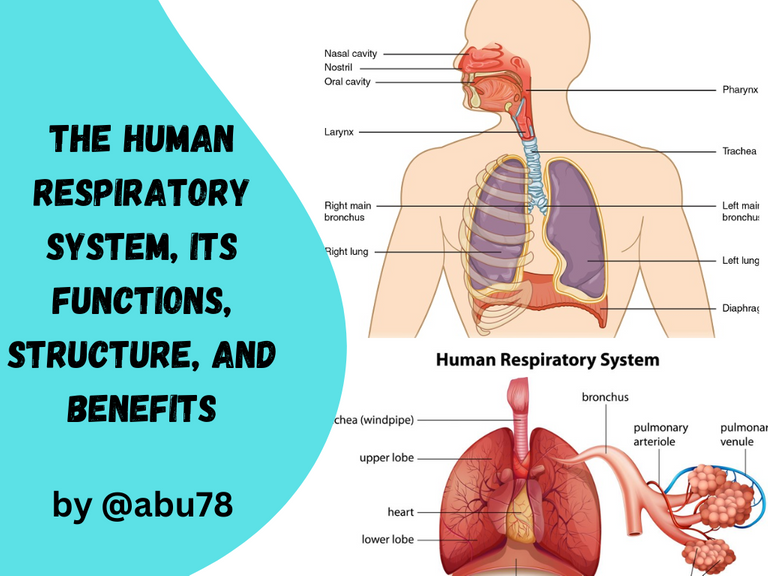The human respiratory system, its structure , functions and benefits
Greetings to all and sundry on this platform once again. As a biochemistry student, today I did my research on "the respiratory system, the structure, functions, and importance" and decided to share it with you guys here. I hope that you will enjoy it and also learn from it. Stay tuned with me as I discuss this topic in my article.

The human respiratory system is an essential part of the body's overall functioning, as it is responsible for the exchange of gases so that oxygen can be taken in and carbon dioxide can be expelled. It is a complex network of organs and tissues that work together in an intricate way to perform this vital function. This system consists of the nose, throat, trachea, bronchi, alveoli, and diaphragm, as well as smaller muscles and other structures that assist in the movement of air.
The nose is the primary organ of the respiratory system and is responsible for filtering the air that is entering the body. The nose contains small hairs that help to filter out dust, dirt, and other particles, as well as mucus to trap these particles before they enter the lungs. The nose also helps humidify and warm the air before it enters the trachea.
The throat, or pharynx, is the passage from the nose to the trachea. The throat contains several structures, including the epiglottis, which helps prevent food from entering the trachea. The throat also contains the larynx, which houses the vocal cords, and the larynx is responsible for the production of sound.
The trachea, or windpipe, is a tube that connects the throat to the two main bronchi. It is lined with cartilage to help keep it open and allow the passage of air. The walls of the trachea are also lined with cilia, which are tiny hairs that help to sweep mucus and other particles out of the lungs, and help to keep the trachea clear.

The bronchi are two main tubes that branch off the trachea and lead down into the lungs. The right bronchus is larger than the left and carries air to the right lung. The left bronchus is smaller and carries air to the left lung. The bronchi are lined with rings of cartilage and cilia to help keep them open and allow the passage of air.
The lungs are composed of several sections, including the bronchioles, alveoli, and diaphragm. The bronchioles are tiny branches of the bronchi that lead to the alveoli, which are small sacs where oxygen enters the body and carbon dioxide is expelled. The diaphragm is a thin, dome-shaped muscle beneath the lungs that helps to expand and contract the lungs to draw in air.
The human respiratory system is responsible for the exchange of oxygen and carbon dioxide, and is essential for life. When we inhale, air enters through the nose and passes through the throat to the trachea and bronchi. The air is then filtered and humidified, and passes through the bronchioles to the alveoli. Oxygen is taken in, and then passed through the blood vessels to be distributed throughout the body. Carbon dioxide is then expelled through the alveoli and out of the body.
Benefits of the Respiratory System
The respiratory system has many benefits, including keeping our lungs healthy and providing the body with the oxygen it needs to function properly. It also helps to regulate our body temperature, as the air that passes through the lungs is humidified and cooled before it enters the body. Additionally, the respiratory system helps to filter out particles and dust that could be harmful to the lungs. Finally, it helps to protect us from infections by trapping and expelling viruses, bacteria, and other microorganisms that enter the body through the air.
In summary, the human respiratory system is a complex and essential system that is responsible for the exchange of oxygen and carbon dioxide. It consists of the nose, throat, trachea, bronchi, alveoli, and diaphragm and works in an intricate way to provide the body with the oxygen it needs and expel carbon dioxide. The system also has many benefits, such as keeping our lungs healthy, regulating our body temperature, and protecting us from harmful particles and infectious agents.
The references given below are sites where you can learn more about the human respiratory system.
Reference 1
Reference 2
Reference 3
Reference 4

Thanks for your contribution to the STEMsocial community. Feel free to join us on discord to get to know the rest of us!
Please consider delegating to the @stemsocial account (85% of the curation rewards are returned).
Thanks for including @stemsocial as a beneficiary, which gives you stronger support.
Congratulations @abu78! You have completed the following achievement on the Hive blockchain And have been rewarded with New badge(s)
Your next target is to reach 8000 upvotes.
You can view your badges on your board and compare yourself to others in the Ranking
If you no longer want to receive notifications, reply to this comment with the word
STOPCheck out our last posts:
Support the HiveBuzz project. Vote for our proposal!